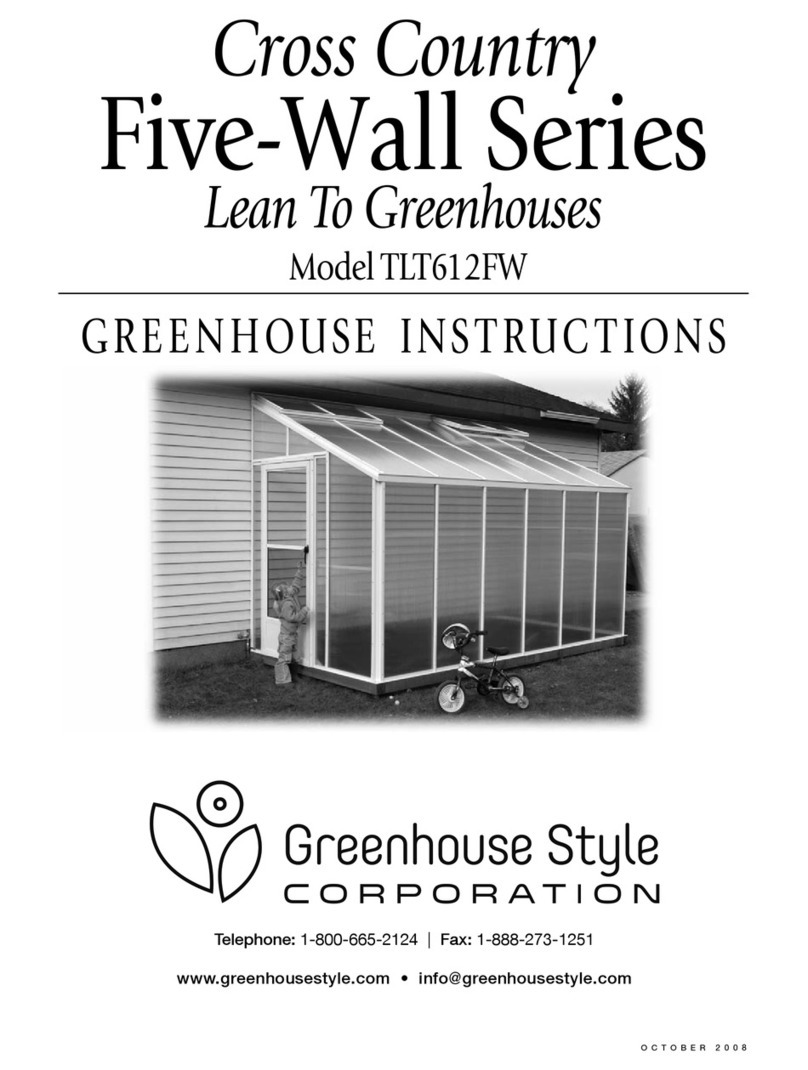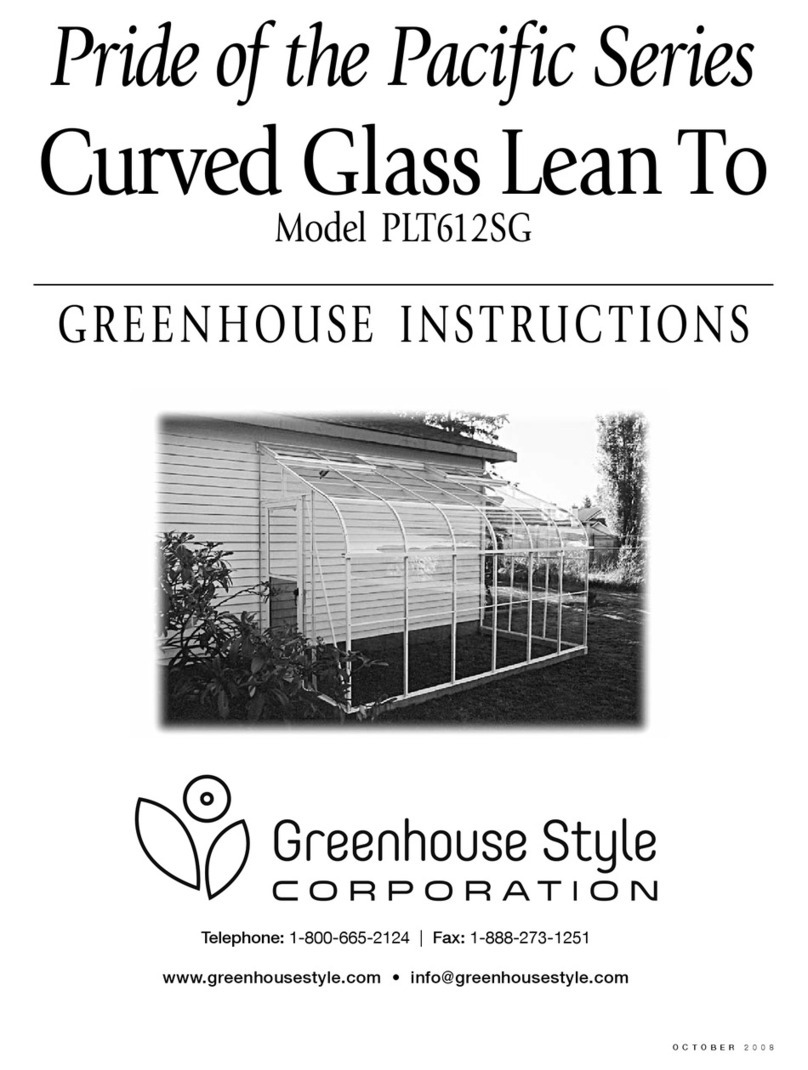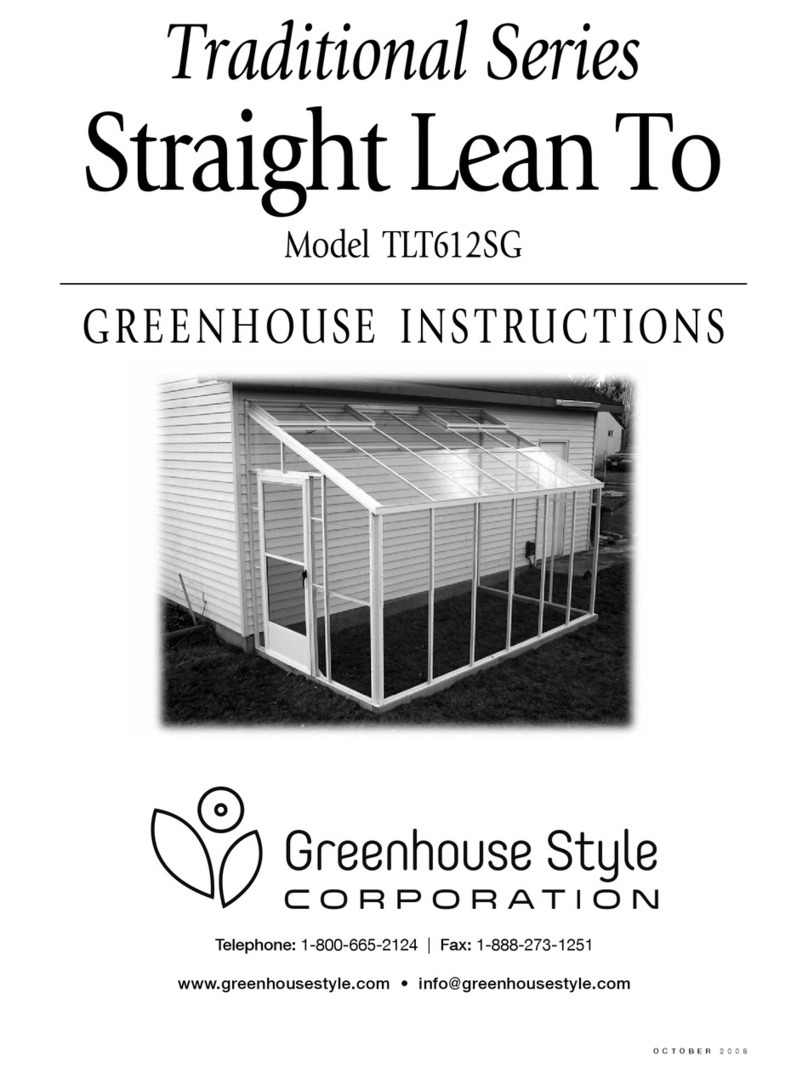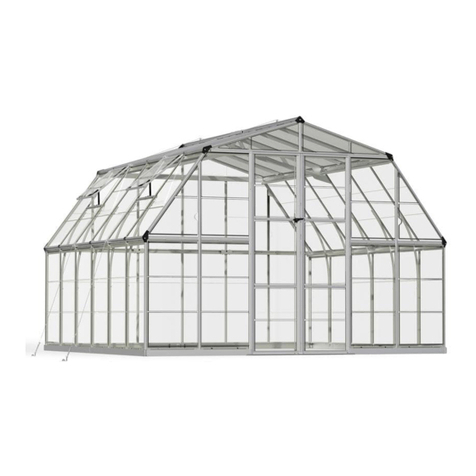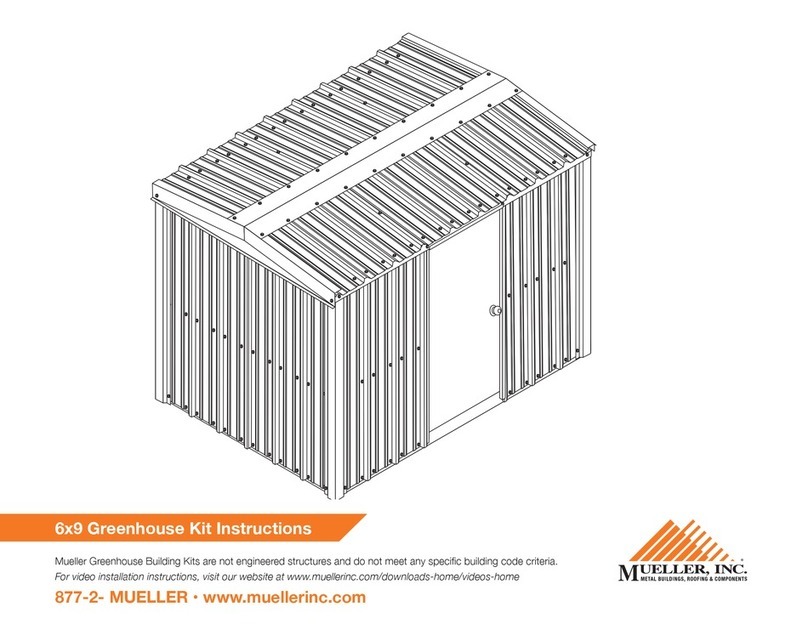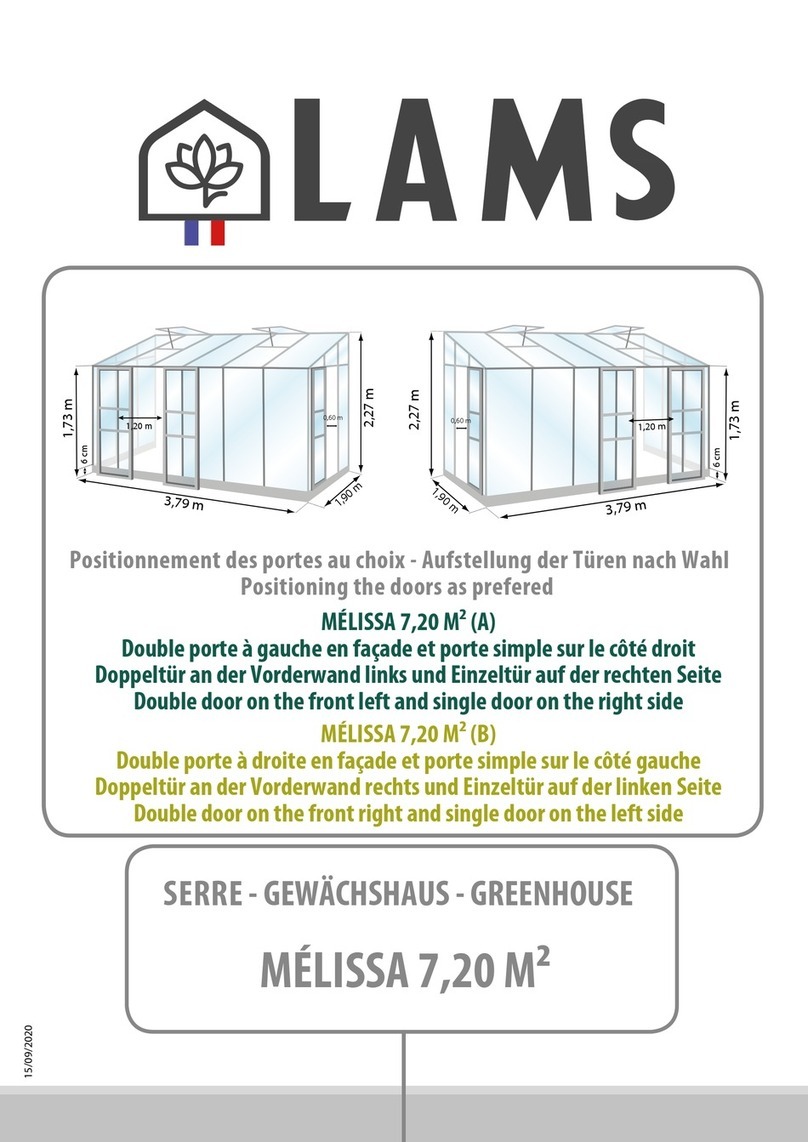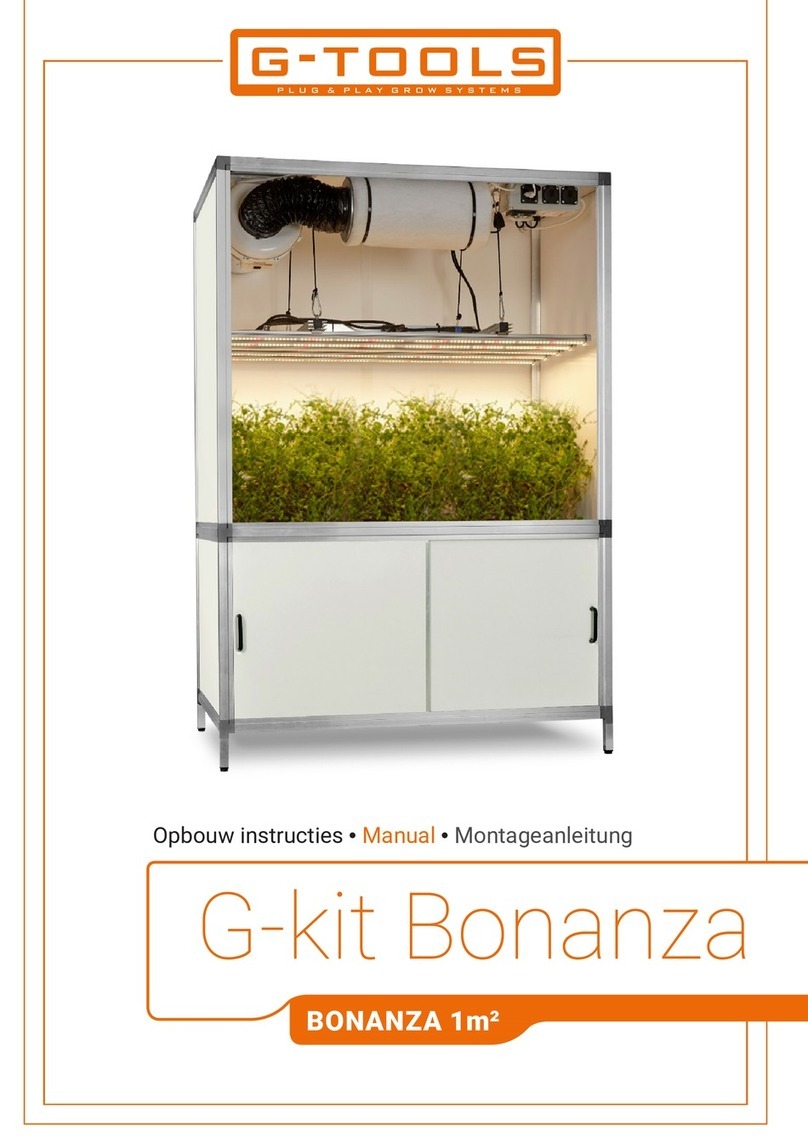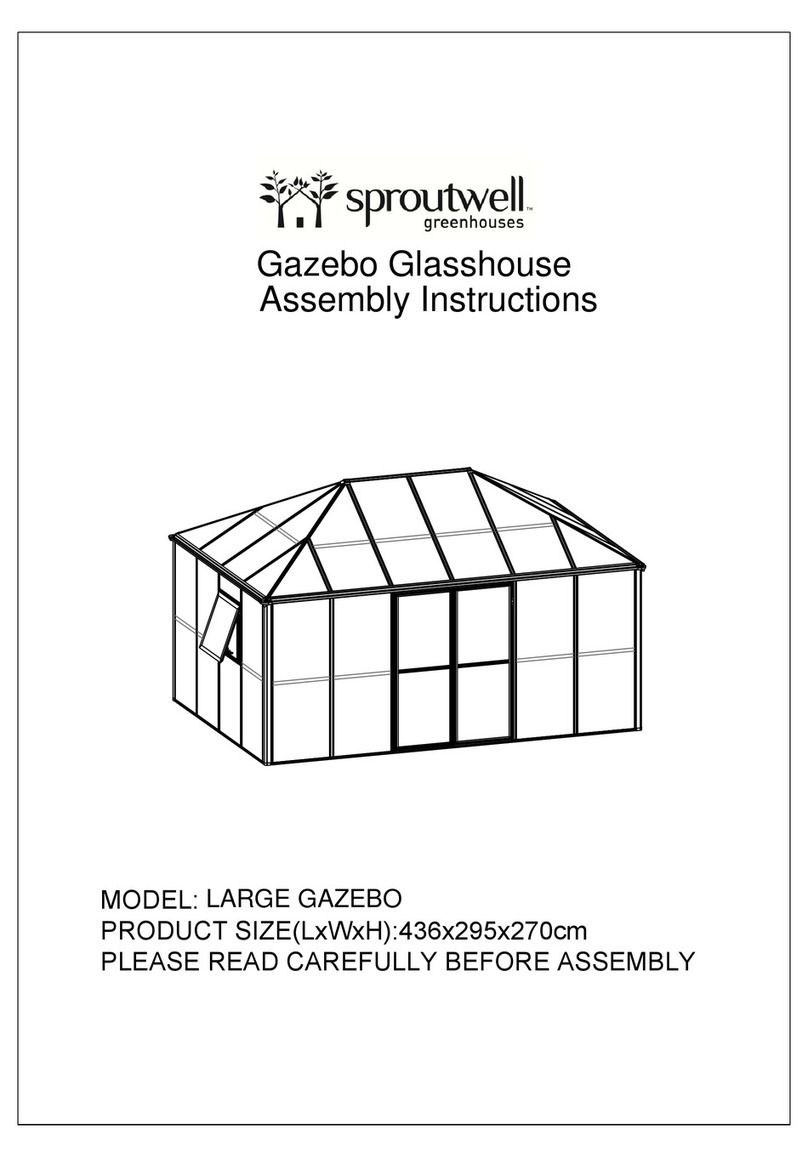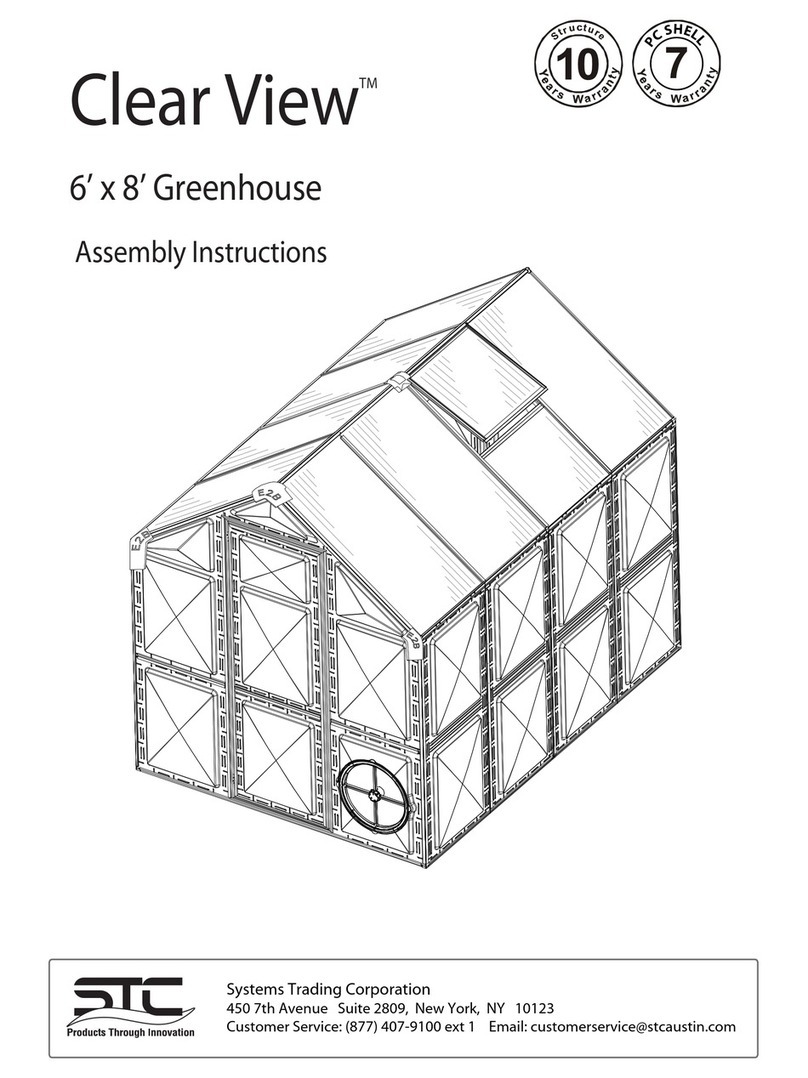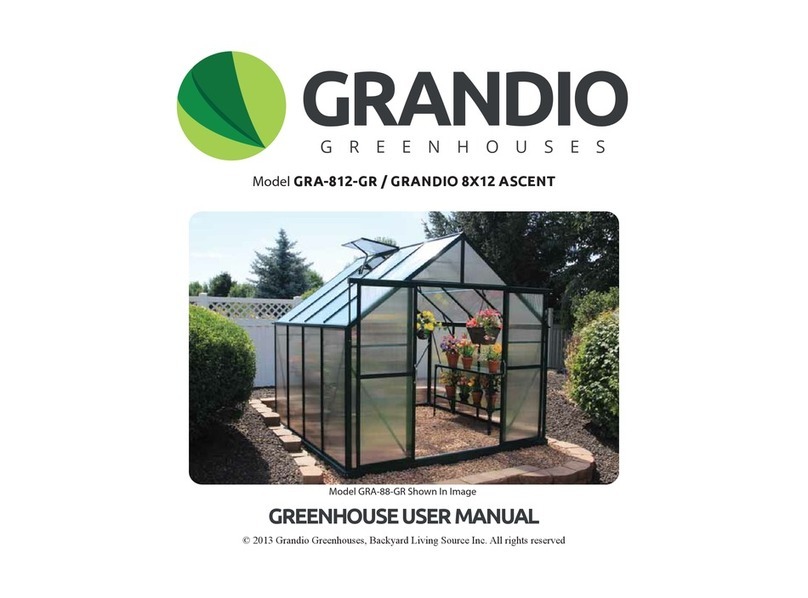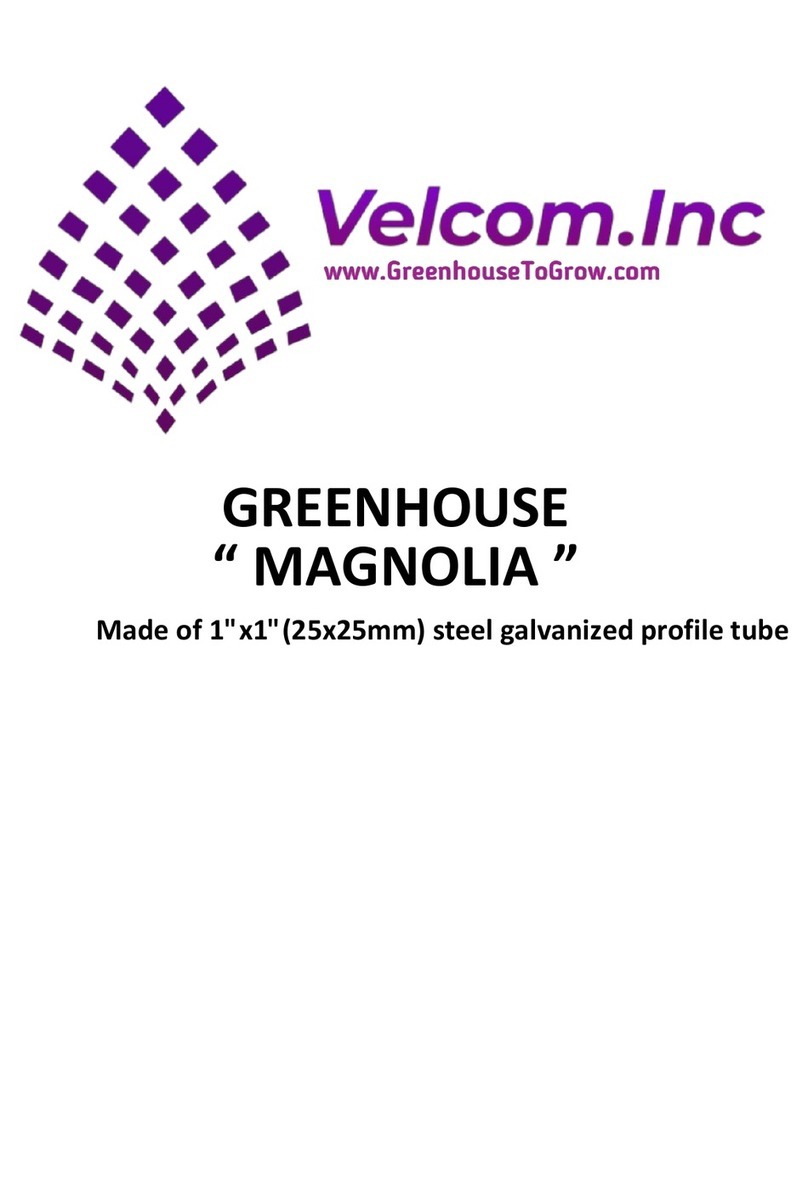Greenhouse Style PC812SG User manual

Pride of the Pacific Series
Curved Model
Model PC812SG
GREENHOUSE INSTRUC TIONS
BCG – THE GARDENERS’ CHOICE SINCE 1951
OCTOBER 2008
A5 - 19327- 94th Ave, Surrey, BC, Canada V4N 4E6
Telephone: (604) 882-8408 • Fax: (604) 882-8491 • Toll-Free in North America: 1- 888-391-4433
Pride of the Pacific Series
Curved Model
Model PC812SG
GREENHOUSE INSTRUC TIONS
BCG – THE GARDENERS’ CHOICE SINCE 1951
OCTOBER 2008
A5 - 19327- 94th Ave, Surrey, BC, Canada V4N 4E6
Telephone: (604) 882-8408 • Fax: (604) 882-8491 • Toll-Free in North America: 1- 888-391-4433
Telephone: 1-800-665-2124 | Fax: 1-888-273-1251
www.greenhousestyle.com • info@greenhousestyle.com

Contents
Foreword ....................................................................... 2
User Notes ..................................................................... 2
List of Drawings ................................................................. 3
Pride of the Pacific Component List ................................................. 4
Foundations .................................................................... 5
Assembly Of The Aluminum Frame
A. Back Gable End Assembly ................................................... 6
B. Front Gable End Assembly With Door ..........................................8
C. Taping Glass bars With Foam ............................................... 11
Aluminum Frame Installation
1. Side Base/Sill............................................................. 12
2. Front Gable End .......................................................... 12
3. Back Gable End........................................................... 12
4. Ridge ................................................................... 12
4A. Truss Assembly Installation (if necessary) ...........................See Appendix A
5. Glass bars With Sliders (#1 or #2)............................................ 13
6. Ventframe Angle .......................................................... 13
7. Glass bars ............................................................... 13
8. Gutter................................................................... 13
9. Roof Purlin (Channel) ..................................................... 13
10. Center Bars .............................................................. 13
11. Tape All Glass bars ........................................................ 13
11A. Side Vents, Intake Shutter and Exhaust Fan Installation (if necessary)...See Appendix B - E
Glass And Cap Installation
General Information....................................................... 21
12. Glazing ................................................................. 21
13A-E. Side / Roof Glazing.....................................................21 - 25
14. Ends .................................................................... 25
15. Sealing The Greenhouse.................................................... 25
Door And Vent Installation
16. Door Installation ......................................................... 26
17. Vent Assembly ........................................................... 28
18. Vent Installation .......................................................... 28
Appendices: Optional Installations
Truss Assembly .................................................... Appendix A
Intake Shutter ..................................................... Appendix B
Exhaust Fan ....................................................... Appendix C
Glass Louvre ......................................................Appendix D
Side Vent . . . . . . . . . . . . . . . . . . . . . . . . . . . . . . . . . . . . . . . . . . . . . . . . . . . . . . . . . .Appendix E
Diagonal Brace .....................................................Appendix F
Purlin Installation..................................................Appendix G
Greenhouse Bench .................................................Appendix H
Side Vent . . . . . . . . . . . . . . . . . . . . . . . . . . . . . . . . . . . . . . . . . . . . . . . . . . . . . . . . . . Appendix I
Roof Vent..........................................................Appendix J
Wire Shelving ..................................................... Appendix K
Miscellaneous Assembly Details: 1–3
– 1 –

Foreword
Your Pride of the Pacific greenhouse is designed and constructed to the highest engineering standards
and provides structural strength and maintenance-free service for year-round gardening pleasure.
The Pride of the Pacific greenhouse must be built upon a firm, level surface. The greenhouse
foundation or sill can be made from pre-treated timbers, concrete or bricks. Whatever your choice
of material, the base must be square and level.
When selecting a site for your greenhouse, keep in mind that a flat, level site is essential so that
the greenhouse can be easily installed and the complete structure is stable and secure. If possible,
choose a site with proper water drainage.
Locating the greenhouse in a north-south position is most suitable for raising summer and autumn
crops since the sun’s rays will be on the greenhouse from daybreak until sunset. An east-west
position is ideal for early spring and winter crops since the winter months, with shorter daylight
hours, still allow six hours of light exposure to the greenhouse.
Try to locate your greenhouse for easy access, especially to the necessary power and water that is
required for greenhouse gardening.
Please watch the enclosed video and follow the steps in this manual for your greenhouse
installation. Remember, if all else fails, read the instructions.
User Notes
The Pride of the Pacific greenhouse structure has been designed
to withstand extreme weather conditions such as high winds and
accumulated snowfall. Hanging baskets and sidewall shelving can
also be attached to its sturdy frame. The greenhouse design also
makes it possible to add extra sections at a later date.
Once a year the greenhouse needs to be completely washed inside
and out. You should do this task when your greenhouse contains
the least number of plants, generally just before the garden plants
are brought in for wintering over. A recommended cleaning
solution is a mixture of hot water with a disinfectant such as Lysol
or Pinesol. Any benches, shelving, plastic trays, pots and baskets
should also be cleaned thoroughly. Prevention is the best known
method for controlling pests and diseases in the greenhouse.
– 2 –
PLEASE NOTE: The
Illustrations found
in this manual may
not be specific to your
greenhouse, however
the detail of aluminum
shapes are all consistent.
The user notes are a
generic instruction for
all Pride of the Pacific
Series Greenhouses
– assembly instructions
are common, only the
sizes number of pieces
and sizes vary.

List of Drawings
Pride Of The Pacific Component List ................................................ 4
Foundation Styles . . . . . . . . . . . . . . . . . . . . . . . . . . . . . . . . . . . . . . . . . . . . . . . . . . . . . . . . . . . . . . . . 5
Back Gable End Line Drawing Assembly Procedure .....................................6
Back Gable End Detail Drawing – Details 1 – 8 .........................................7
Front Gable End (With Door) Line Drawing Assembly Procedure ......................... 9
Front Gable End (With Door) Detail Drawing – Details 1- 12 ............................ 10
Taping Glass bars With Foam.......................................................11
Assembly Outline: Aluminum Frame Steps 1-10 ...................................14 - 20
Glass Installation Steps 12-14 .................................. 21 - 25
Door Installation................................................................ 27
Vent Assembly - Exploded View.................................................... 29
Greenhouse Architectural Details .................................................. 31
Truss Assembly .......................................................... Appendix A
Intake Shutter ........................................................... Appendix B
Exhaust Fan ............................................................. Appendix C
Glass Louvre ............................................................Appendix D
Side Vent ................................................................Appendix E
Diagonal Brace ...........................................................Appendix F
Purlin Installation ........................................................Appendix G
Greenhouse Bench .......................................................Appendix H
Side Vent ................................................................Appendix I
Roof Vent................................................................Appendix J
Wire Shelving ........................................................... Appendix K
– 3 –

Pride of the Pacific Component List
Tools
#2 Square head
screw driver
Measuring tape
Level to check foundation
3/16” concrete bit
(concrete foundation)
9/64” aluminum bit
7/16” wrench
Razor blade cutter
Caulking gun
Ladder
Hammer
Optionals
Automatic Opener
Circulating Fan
Max/Min thermometer
Benches
Eyebolts
Motorized Intake Shutter
Exhaust Fan
Thermostat
Heater
– 4 –
Ridge Glass Cap & Glass Bar Glass End Bar Ventframe Bottom
Bracing Angle Plastic h came Vent Frame Sides Purlin (if required)
Screws and Bolts Base / Sill Door Frame Gutter

– 5 –
Foundations
Check your local building codes for foundation requirements in your area.
CONCRETE FOUNDATIONS
When you prepare the concrete foundation, the size should be exactly the same as the outside
dimensions of the greenhouse.
PRE-TREATED WOOD FOUNDATIONS
A greenhouse that is approximately 100 sq. ft. (9.3 m2) can be fastened to a 4” x 4” pre-
treated wood timber foundation. For larger greenhouses, a 6” x 6” wood timber foundation is
recommended. These timbers are placed on a 4” (10 cm) deep and 8” (20 cm) wide gravel bed.
Wood timbers can be stacked to increase the height of the greenhouse. One advantage of the wood
foundation is that it is not classified as a permanent structure. Therefore, if you move, the greenhouse can
be dismantled and moved to another location. IMPORTANT NOTE: Please see the last page of this
manual for important information regarding the ‘New’ Pressure Treated wood.
A SQUARE AND LEVEL FOUNDATION
Check the width and length of the foundation’s outside dimensions. Then, square the foundation
by measuring diagonally from opposite corners in the form of an “X”. Next, use a long carpenter’s
level to check and adjust the foundation until it is level. Finally, measure where the door will be
placed (in most cases it is 341/2” wide). Mark these measurements on your foundation.
PRE-TREATED WOOD FOUNDATION
Foundation Styles
Pressure Treated
Wood
4x4, 4x6, 6x6
Concrete Wall or
Concrete Block
with Pressure
Treated Wood
Plate
Concrete Wall
with
Footing
Concrete Wall
with
Footing and
Brick Facing
Gravel
Pre-cast
Concrete Pier
Block
Pressure
Treated
Wood
Pressure
Treated
Wood
Truss on
Models over
13’ Long
Truss on
Models over
13’ Long Truss on
Models over
13’ Long
Truss on
Models over
13’ Long
NOTE:
8” Concrete
Wall on Gable
Ends, models
over 16’ wide
(see detail)
Flashing by
Others
Flashing by
Others

Pressure Treated Wood
WHAT IS NEW ABOUT PRESSURE TREATED WOOD?
As of January 2005, the chemicals used in pressure treated wood have been changed. Previous
wood was treated with arsenic. However due to the potential long term health hazards this has
been discontinued. New pressure treated wood is treated with copper.
The copper in the ‘new’ wood will be CORROSIVE TO ALUMINUM as well as other metals.
What are ‘Greenhouse Friendly’ solutions to the new pressure treated wood?
1 If you are using the new pressure treated wood, you must place a barrier between the wood
and your aluminum frame. Popular barriers include 10 mil thick plastic sheeting, steel
weather flashing, a rubber or foam weather membrane, or a row of weather resistant non-
treated wood such as cedar or hemlock.
2 Other weather resistant non-treated woods are popular alternatives to pressure treated wood.
These contain no harmful chemicals and will outlast pressure treated wood. Cedar timbers
are a popular choice for greenhouse foundations.
3 Concrete foundations have always been suitable foundation alternatives for greenhouses.
They can vary from poured concrete slabs, poured concrete perimeter walls to concrete block
walls. Although these are usually more costly than wood alternatives, they have the benefit
of lasting a lifetime. As they are usually considered a permanent foundation, it is important
to check with your building codes to determine what you are able to build.
If you have any questions about using the ‘New’ pressure treated wood in conjunction with our
aluminum greenhouses, please contact our office at 1-888-391-4433.

Assembly of Aluminum Frame
A. BACK GABLE END ASSEMBLY
Lay out the back pieces into the shape of the end wall. Refer to the line/detail drawing.
1. For the curved glass end bars, the flat surface should lie on the ground.
(See the example to the right.)
2. Bolt the glass bars on the top first. (See Page 7, Detail #2 & #4 ) The center glass bar is not
bolted to the top. You will notice an angle piece on the top of the glass bar (although it is not
always pre-installed). This angle piece is for fastening to the ridge. (See Page 7, Detail #3)
3. Bolt the base/sill to the bottom of the glass bars. (See Page 7, Detail #6)
4. The angle brace is bolted approximately 54” from the base. The slider brackets that have already
been screwed to the curved glass end bar will determine the height. (See Page 7, Detail #1 & #8 )
When bolting the center of the back wall, measure the back wall so that it does not sag.
(See Page 7, Detail #7)
– 6 –
Back Gable End Line Drawing Assembly Procedure
GROUND
1 2
3 4
Curved Glass End Bar Glass Bars
1” x 2” Angle Base Cross Brace

– 7 –
1
Back Gable End Detail Drawing – Details 1-8
2 3 4
87
6
5

B. FRONT GABLE END ASSEMBLY WITH DOOR
1. Lay out the front pieces of the greenhouse into the shape of an end wall. The doorframe
and all the glass bars have a track for the bolt. The track must face up when you assemble
the gable ends. Slide the bolts into the track of the bars or use the notches that have already
been punched out in the bars (Refer to the line/detail drawing on the following page. The order of
assembly is represented by dark lines, See Page 9). When you are assembling the greenhouse, you
can view the sketches and drawings from the inside the greenhouse. Bolt the bottom plates
(4 holes) to the base/sill and the doorframe sides using 1/4” x 1/2” stainless steel bolts (See
Page 10, Detail #1 or #2). Before tightening the bolts, be sure that it is square. (If you ordered a
greenhouse with a door drop, measure from the bottom of the doorframe to the underside of the base
according to the specified distance.)
2. At the top of the doorframe, put on the doorframe header (which looks the same as the side
pieces). Put the header between the two side pieces and bolt on the plates (6 holes) (See Page
10, Detail #3 & #4). The plates should stick up 1” above the doorframe. Note how the plates
are put on. Before tightening the bolts, be sure to square up the doorframe.
3. The 1” x 2” angle above the door (49 3/4” long) can now be bolted on. The 1/4” round
holes should be lined up with the holes in the plates. Each end of the 1” x 2” angle has a slot
punched out to accommodate the bolt. This slot lines up with the bolt track in the glass bars
beside the door.
4. Take all the glass bars and bolt them to the base/sill (See Page 10, Detail #12). The angle cut
on the glass bar should match the roof slope.
5. Each curved glass end bar has at least one small aluminum bracket attached to it with two
1/4” holes drilled in it. These pieces line up with the upright glass bar(s). Both sides are the
same (See Page 10, Detail #5 & #6).
6. When the upright glass bars are fastened to the angle that is attached to the curved glass end
bar, bolt on the short glass bar above the door to the 1” x 2” angle (See Page 10, Detail #7).
Do not worry about the small cleat bolted on the bar. This will be fastened later.
7. The diagonal bracing can now be bolted on. Remove the bottom nut in the top plate and
insert the brace. Then put the nut back on (See Page 10, Detail #8 & #9). There are 1/4” holes
in the base, use 1/4” x 1/2” bolts to fasen the oher end of the diagonal brace to the base (See
Page 10, Detail #10 & #11).
8. Be careful when you stand up the front end of the greenhouse because the curved glass end
bars are quite loose. It may have only two bolts in it. Wrap the bottom of the end bars to the
base using a polywrap, or tape it if you are handling the end by yourself.
– 8 –

– 9 –
Front Gable End (with door) Line Drawing Assembly Procedure
1 2
3 4
5 6
7
Plate
1” x 2” Angle
Plates
End Glass Bar
Glass Bar
Angle Brace
Glass Bar
Door Frame Sides
Door Frame Top

12
Front Gable End (with door) Detail Drawings Details 1 – 13
5
(No Door Drop) (No Door Drop)
(No Door Drop Close Up)(Door Drop Close Up)
8 7 9 3 4 6
10 1 2 11
– 10 –

Door Frame Assembly

C. TAPING GLASS BARS WITH FOAM
Tape all the aluminum Glass Bars with 1/8” foam tape. The curved glass end bars tape on one
side only. All other Glass Bars tape on both sides. Take a roll of tape and start at one end and
press on the bar. Make sure that the aluminum is dry. Taping it at this time, you can still move
all the pieces in the shed or undercover if it is raining.) Slowly roll down the tape toward
the outer edge and press it down at the same time. (See pictures below) Be careful because
sometimes the edge of the paper is quite sharp. Do not remove the paper until later.
NOTE: Do not tape the place where the Glass Bar is notched out.
When all bars are completed, including the end walls, go to Step #1 of the aluminum frame
installation on the next page.
– 11 –
Do NOT put foam tape along the End Bars. The
glass slides under the lip and needs to be sealed
when the greenhouse is finished

Aluminum Frame Installation
Check that the foundation is level and square. If your
foundation is larger than the greenhouse, mark a line
on it with a pencil or with a chalk line. Take a caulking
gun and put in a tube of caulking. Cut 1/4” off the top at
a 25-degree angle. Then put a bead of caulking on your
foundation approximately 1” in from the outside of the
foundation or the marked line. DO NOT CAULK THE
DOOR OPENING. Measure your door opening in the
front.
1. SIDE BASE/SILL
Lay down the aluminum side base/sill flush with your base on the line you have marked out.
Push down on it so that the caulking squeezes out. (See Step 1 Detail, page 14.)
2. FRONT GABLE END
Stand up the front end between the side pieces flush with your base or marked line. Slide
up one bolt in the bottom of each glass end bar (front). Take the end bar and push it into
the side base where it is notched. The back of the bar lines up with the first slot in the side
base/sill. Slide the bolt down and fasten it. Do the same for the other side. When you are
lined up and in the right place, screw down the front base/sill using the screw holes that
are already there. Then put one screw in the side base on each side of the front gable end.
When you have fastened down the front, it should stand by itself. (If it is windy, you will
need another person to hold up the front, or you can use a stepladder so that the front can lean
against it.) (See Step 2 Detail, page 14.)
3. BACK GABLE END
Follow the same procedure for the back gable end as you did for the front. When you have
bolted it to the side base and it lines up flush with your base/sill or marked line, then you
can proceed. Fasten the base/sill down to your foundation with the screws that are provided.
When fastening the side/base sill to the foundation, be sure that the base is straight.
(See Step 3 Detail, page 14.)
4. RIDGE
Before you slide in the ridge, put one bolt in the top of each end bar. Take the ridge (one
person at each end) and slide it between the end bars on the top. You will notice the punched-
out slots in the bottom flange of the ridge. The slots on the end line up with the bottom side
of the curved glass end bar. Now slide in the ridge and slide the bolt into the ridge slot. Make
sure that the glass end bar is tight against the ridge. (See Step 4 Detail, page 15.)
4A. SEE APPENDIX A FOR TRUSS ASSEMBLY INSTALLATION FOR
GREENHOUSES LONGER THAN 16 FEET.
– 12 –

5. CURVED GLASS BAR WITH SLIDERS (#1 OR #2)
Each glass bar is marked with a number (1, 2, 3 . . .) to correspond with the number on the
ridge. Slide the bolt into the top of the glass bar and line it up with the slot in the ridge. Move
up the bolt and fasten it. Do the same for the bottom of the glass bar. Slide in the bolt, push
it down against the side base/sill. Bolt it on. Do this for all the glass bars with sliders and
numbers (The end of the bar should be tight to the base and ridge).
(See Step 5 Detail, page 16)
6. VENTFRAME ANGLE
The ventframe angle is 50” long with the ends cut out to fit between the two glass bars with
sliders. Put the head of the bolt into the punch out in the glass bar (24” from the top), slide
the bolt up and fasten it to the ventframe on the bar. Make sure that the angle flanges are
facing toward the sidewall (down) and that it is pushed up against the side sliders (already
on the glass bar). Do this for all of them.
(See Step 6 Detail, page 17)
7. GLASS BARS
Bolt on all the remaining glass bars. Make sure that the top and bottom is tight against the
ridge and base. (See Step 7 Detail, page 18)
8. GUTTER
The gutter is also used as a spacebar. The gutter is located just below the curve approximately
54” up from the base (The glass bar should be notched out for it). Use #8 x 1/2” screws to fasten
the gutter to the glass bar (Keep the gutter to the top of the notch). (See Step 8 Detail, page 19)
9. ROOF PURLIN (CHANNEL)
When installing the roof purlin, mark it out by measuring from the ridge. The roof purlin
should be located (refer to drawings for purlin placement). In larger greenhouses, the purlin
may be located about the center between the ridge and the top of the curve. Always face the
open end of the purlin up towards the ridge so that it can be used for hanging baskets. Every
glass bar has notches punched out so that the head of the bolts can be inserted and can slide
up or down on the bar. (See Step 9 Detail, page 20)
10. CENTER BARS
Fasten the center glass bar in each end wall. Use a 1”x 2”x 1” small angle with a 1/4” hole
drilled in the 2” side. Put a bolt in the center glass bar and attach the small angle to it. Slide it
up to the ridge. It will be on a 24-degree angle. Clamp it on with vice grips. Then drill a 9/64”
hole in the ridge and screw on the glass bar. Make sure that the glass bar lines up the same as
the other bars in the front and back. The 10-foot wide Pride of the Pacific Model does not have this
center bar in the back wall. (See Step 10 Detail, page 20)
11. TAPE ALL GLASS BARS
Complete all taping with the 1/8” foam gasket. NOTE: Side vents need to be installed before
taping the bars. (See photographs, page 12.)
11A.SIDE VENTS, INTAKE SHUTTER AND EXHAUST FANS INSTALLATION
(IF NECESSARY) SEE APPENDIXES B THRU E. THEN RETURN TO THE
NEXT PAGE AND CONTINUE
– 13 –

Assembly Outline
Step 2: Front Gable End Step 3: Back Gable
– 14 –
Step 1: Side Sill & Base

– 15 –
Step 4: Ridge
Inside Front View Back Inside ViewOutside View

Step 5: Glass bar with Vent Frame Sliders
– 16 –
1122

– 17 –
Step 6: Vent Frame Bottom
Table of contents
Other Greenhouse Style Greenhouse Kit manuals
Popular Greenhouse Kit manuals by other brands

AeroGarden
AeroGarden 507140-0000 AD Planting & growing guide
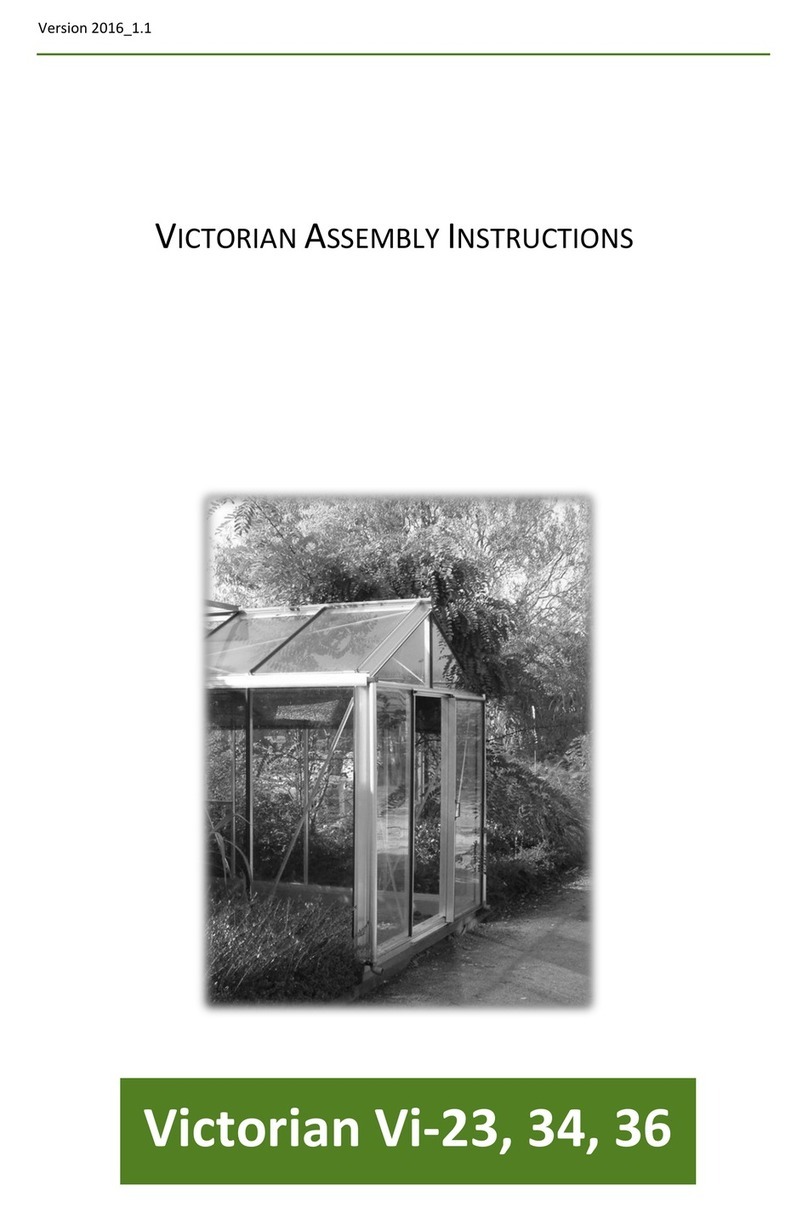
Janssens
Janssens Victorian Vi-34 Assembly instructions
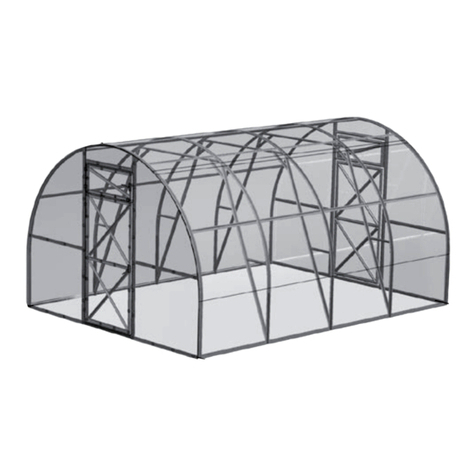
Barney
Barney Dachnaya Tryoshka Assembling manual
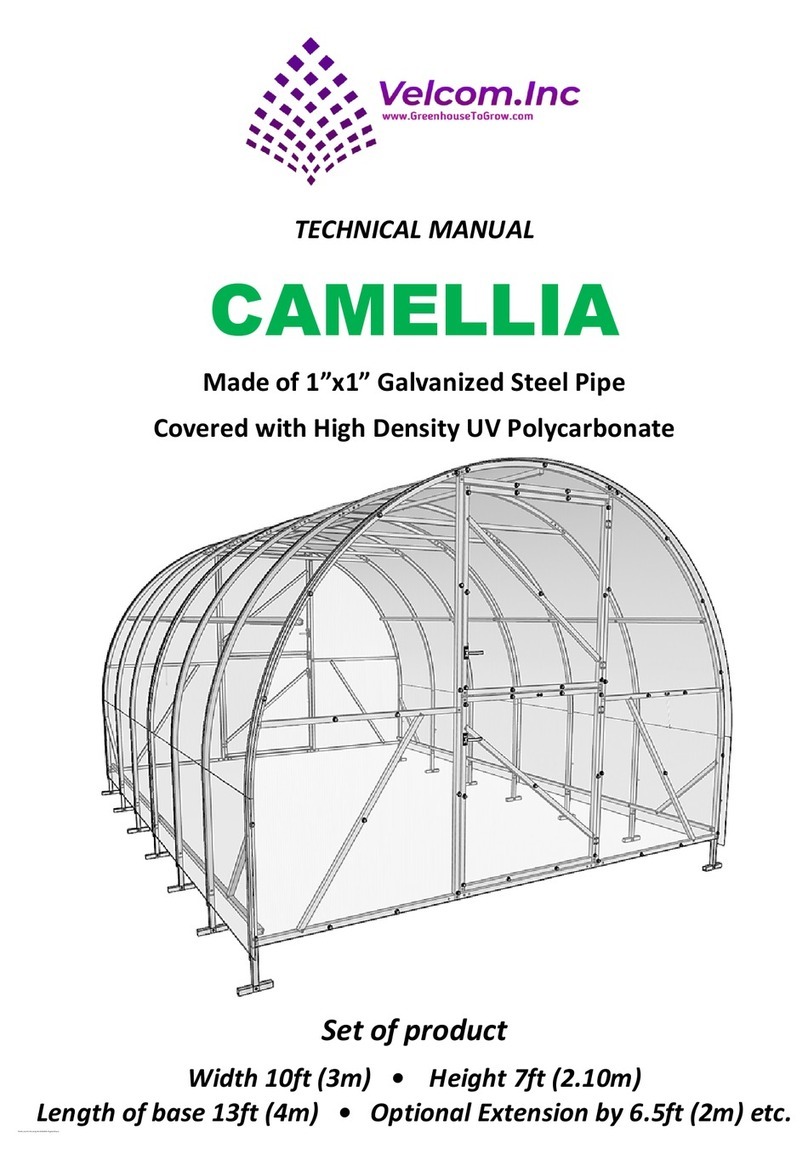
Velcom
Velcom CAMELLIA Technical manual

Palram
Palram CANOPIA HARMONY How to assemble
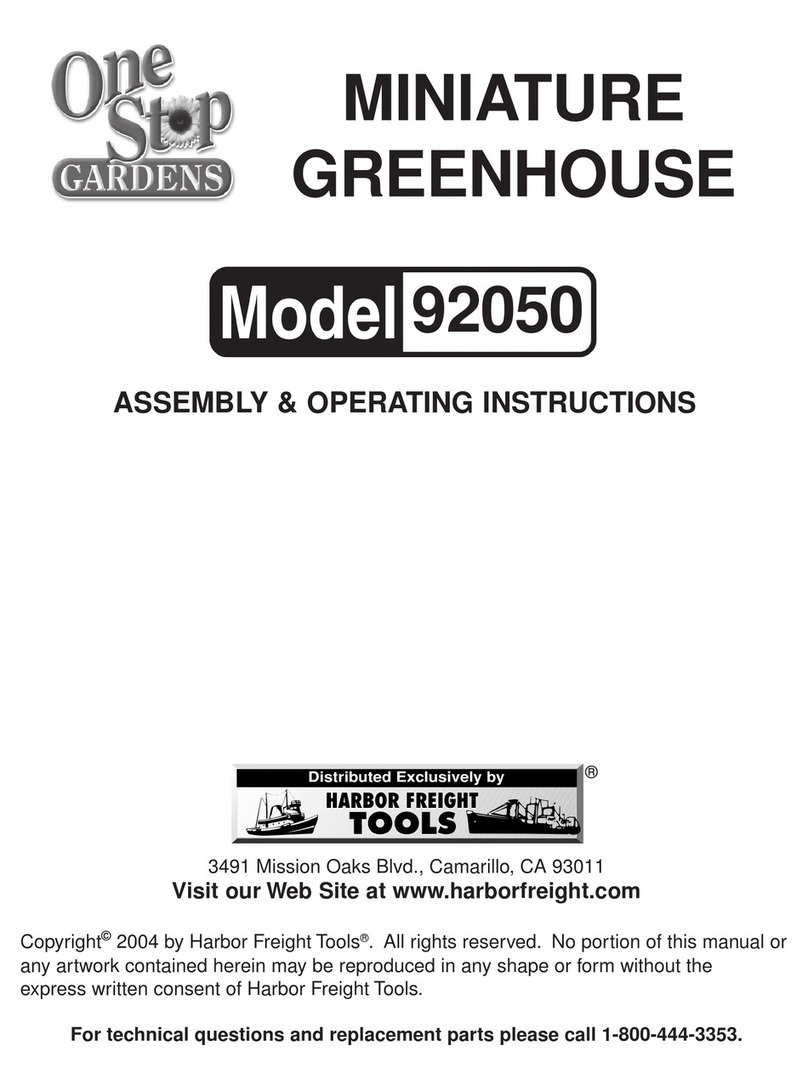
One Stop Gardens
One Stop Gardens ONE STEP GARDEN 92050 Assembly & operating instructions
